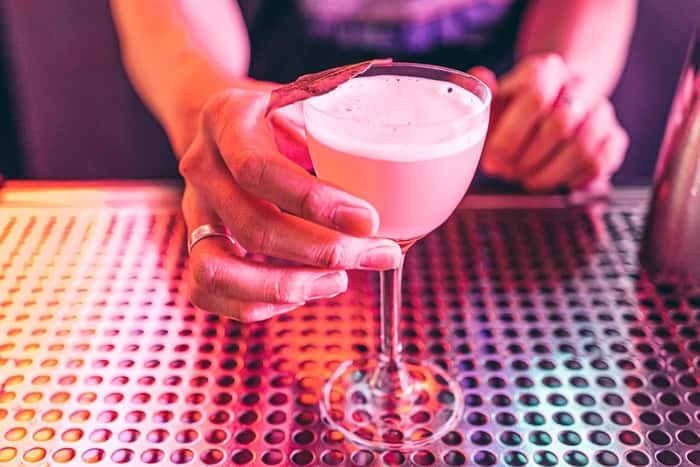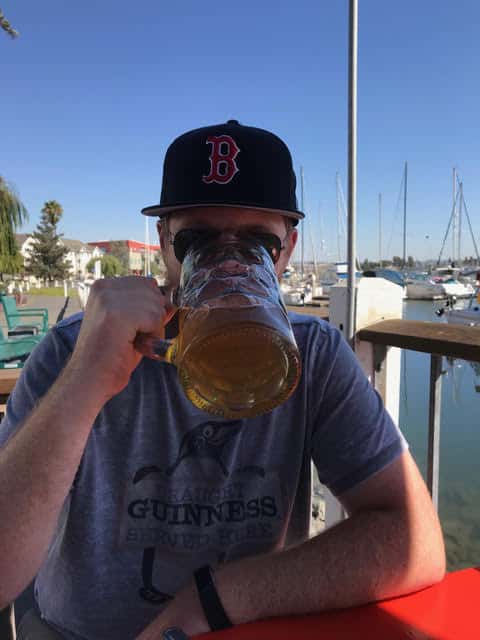
The latest buzz in craft beverages, whether beer, wine, or spirits, is the rapidly growing “better for you” category of drinks. Consumers want tasty choices when they go out for a drink. But that doesn’t always mean they are looking for the alcohol to go along with the flavor.
According to research done by FiorMarkets, non-alcoholic drinks are expected to grow at about eight percent per year, globally, through 2028. That means huge opportunity for non-alcoholic producers and plenty of room for exciting new brands to get in on the game.
Especially when it comes to cocktails, the health-conscious trend has led to lower-calorie and low- or no-alcohol refreshments.
Often dubbed “mocktails,” these alcohol-free drinks are simply cocktails without the alcohol. They can run the gamut from mimicking a classic cocktail like an Old Fashioned (minus the whiskey) or be a completely from-scratch recipe. Either way, the mocktail has opened new creative doors to bartenders all over the country and helped business owners boost their bottom lines.
In the past, non-alcoholic drinks have been an oft-maligned category, dismissed as flavorless, bland beverages. Drinking booze-free used to mean sacrificing flavor and enjoyment. But in the midst of the craft beverage revolution we find breweries and bars proving that notion entirely wrong. Today, bars, restaurants, and breweries across America have developed flavorful, inventive, and attractive mocktail menus that cater to everyone.
These sober drinks are something that you should consider adding to your menu to attract a variety of consumers.
What We’ll Cover in This Piece:
What Are the Advantages of Adding Mocktails to Your Menu?

Photography courtesy of Patio29 Spirits Company
There are many advantages of adding non-alcoholic drinks to your menu. First and foremost, in this era of health-conscious consumers, mocktails provide an alcohol-free alternative to a rising group of drinkers.
According to data from a 2019 Nielsen survey, sixty-six percent of Millennials say they were making an effort to reduce their alcohol consumption. When Nielsen began tracking this data in 2018, fifty-four percent of consumers said they abstained from alcohol at some point that year, with fifty percent citing health as the primary motivator.
And the trend has only continued to grow. In 2021, according to IWSR, consumption of low- and no-alcohol drinks rose one percent in ten key markets, including the U.S., Germany, Japan, and Brazil. And while alcohol still far outpaces the sales of buzz-free beverages, the global consumption of low- and no-alcohol beer, wine, and spirits is growing two to three times faster than overall alcohol consumption.
As a bar, restaurant, or brewery owner, staying on top of current trends will be paramount to catering to your community. Offering a sober-curious menu means those who are choosing to be health-conscious or abstain from alcohol will still be able to go out with their friends and enjoy a drink.
Keeping all of your customers entertained and happy is increasingly important to help your business stand out in a crowded market. Mocktails can be that extra detail that attracts new patrons.
Instead of just offering sparkling water with a lime wedge, adding booze-free cocktails with ingredients like fresh, local fruit juice or house-made mixers will help your establishment stand out.
At Viridian Bar in Oakland, CA, Co-Founder and Bar Director William Tsui curates a mocktail menu full of hyper-seasonal, local produce to set his bar apart from the stiff competition. “It’s all about capture,” says Tsui, meaning you can capitalize on every customer that walks through the front door. Just because a customer isn’t drinking alcohol shouldn’t mean they can’t patronize your business.
California’s stone fruit season means fresh pluots, a descendant of a plum and apricot hybrid. Tsui takes advantage by incorporating pluots into a riff on a whiskey sour. But next season, who knows? Depending on the ingredient, the idea, and the finished drink, Tsui will consistently rotate the mocktails available on his menu.
Across the country in Portland, ME, Liquid Riot Bottling Company put a variety of house-made sodas and mocktails on its non-alcoholic menu. Vice President of Operations Matthew Marrier says the focus is on fresh ingredients for their alcohol-free drinks. “We do use fresh ingredients for our sodas and mocktails,” Marrier says, whose house-made ginger-lime soda, blueberry soda, and cola sound a lot more enticing than the handful of sugar-laden commodity brands often typically sold in bars.
One non-alcoholic menu staple at Liquid Riot is the No Pain, No Gain mocktail. Packed full of flavors including passion fruit, coconut, lemon, orange, and a ginger-honey concoction, this mocktail won’t even make you miss the booze.
Overall, having fun, flavorful, sans-alcohol options for your customers is a win-win for everyone.
What Types of Mocktails Work Well?

Photography courtesy of Liquid Riot Bottling Company
If you do decide to craft a mocktail menu, there are a couple different routes you can take.
First, you can simply stick to the classics. According to Tsui, Viridian’s mocktails are often a play on a classic cocktail, with just three or four ingredients. Balance is key, but with that handful of ingredients, “You can make a mocktail just as complex as a cocktail,” says Tsui.
Tsui likes to start with a base recipe, explore where he can swap different ingredients in or out, and incorporate seasonal produce into that overarching structure. At Viridian Bar, the mocktail menu is based almost entirely upon seasonality of local produce. Whenever they can utilize fresh and local ingredients, they do.
Of course, one way to hew close to the classic recipes is to use zero-proof spirits. From California to the United Kingdom, producers are offering “spirits” that are in the 0.5% ABV range, or entirely alcohol free. Vodka, whiskey, rum, gin, and more are available in non-alcoholic form. This might not be the creative stimulation that many bartenders seek, but it’s an increasingly available option.
Second, you can get super creative. Forgo the Old Fashioneds, Negronis, and French 75s for completely new recipes. Creativity is the name of the game, as it provides an artistic outlet for bartenders, and also keeps customers intrigued.
Whether you’re making a classic mocktail or an entirely new recipe, removing alcohol from a drink doesn’t cut out the time and effort involved with making it. Mocktails are still hand-crafted drinks that require recipe development, testing, and execution. For that reason, you need to carefully consider how to price these creations.
How to Price Your Mocktails

Photography courtesy of Viridian
The added care and attention to detail that go into booze-free offerings means prices can edge slightly higher than say a simple non-alcoholic soda or sparkling water. It’s similar to how cocktails are pricier than a pint of beer.
As we have seen with the rise of handcrafted, artisanal beverages, consumers are willing to pay a premium price for a premium product. These days, non-alcoholic drinks often find themselves in the higher-end category on an establishment’s drinks menu. Tsui says this is because “there is still the craft behind it, the intention behind it.”
But overall, since non-alcoholic menus don’t provide the buzz of classic cocktails, you can keep the price of these drinks reasonable. At Liquid Riot, mocktails run about eight dollars, while drinks on the traditional cocktail menu hover around fifteen dollars.
In certain instances, you can even offer mocktails for free.
In Northern California’s wine country, Patio29 Spirits Company offers complimentary mocktails to designated drivers. Patio29 is a distillery with no kitchen on site, and as a result they offer a different experience than traditional restaurants. Without the ability to offer food, Patio29 has to pay extra attention to guests’ consumption of alcohol. Providing mocktails for those who aren’t drinking is one easy way to reward responsible behavior. However, this will affect your bottom line because there is still time and effort that goes into crafting artisan mocktails.
In the future, Patio29 has plans for a kitchen, which will enable them to expand the drinks menu as well. When that time comes, the complimentary non-alcoholic drinks will likely go on the menu at about half the price of cocktails. The plan is for somewhere in the five- to six-dollar range for mocktails.
Patio29’s Tasting Room Manager Eric Boone says that those looking for non-alcoholic options “will generally not result in bottle sales,” and therefore recouping some of the cost that goes into producing mocktails is quite helpful.
Keeping the alcohol off the ingredient list may help keep the price down, but it doesn’t have to tamp down the flavor or experience you can offer your guests.
Consider Dry January
If you’re looking for the right moment to start implementing a mocktail menu or ramp up one you already have, consider “Dry January”. Many people decide to give their liver some time to rest and recuperate after the holiday season, when we tend to overindulge in food and drink. Dry January is essentially the idea of refraining from consuming alcohol for the entire month. While the all-or-nothing approach can turn some off the idea, nearly ten percent of people aged thirty-five to forty-four in Great Britain gave it a shot in 2020 according to a report from Statista.
And it’s not just January, either. The lesser-known March Parch, Dry July, and Sober October are timely periods of the year when some people decide to go alcohol free. If you are considering implementing a mocktail menu, January of 2022 may be the perfect time to start.
A Final Word on Mocktails

Photography courtesy of Liquid Riot Bottling Company
Providing a great experience for guests is critical, whether they are looking for the buzz provided by alcohol or they want to enjoy their time out while remaining sober for the drive home. When a group goes out for dinner and/or drinks, there’s no guarantee that everybody will be looking for a buzz. Having options available, such as a mocktail menu for those who want a drink with no booze but full flavor, is quickly becoming crucial to meeting the desires and demands of today’s consumer.
Other Content You May Enjoy
To succeed and grow your restaurant, bar, or brewery you need to stand out in local search results. Whether someone is searching for the “best craft beer near me” or “top-rated seafood restaurant in [your city],” Local SEO (Search Engine Optimization) helps your business appear at the top of those search results.
With 81% of consumers using Google Search and Maps to find local businesses, and nearly 90% of customers choosing a business on the first page of search results, optimizing your online presence is essential.
This guide will walk you through Local SEO strategies tailored for restaurants, bars, and breweries, covering Google My Business, website optimization, online reviews, local backlinks, and more.
By the end of this guide, you’ll have a step-by-step action plan to increase your search rankings, attract more local customers, and grow your business.
In today’s digital world, having a well-designed, functional website is essential for restaurants, bars, and breweries. It goes beyond having social media. A great website can help attract new customers, showcase menus, accept reservations, and even drive online sales. But one of the most common questions business owners ask is: How much should a website cost in 2025?
The answer depends on several factors, including the type of website, features, complexity, and whether you choose a DIY solution or hire a professional web developer. Costs can range from a few hundred dollars for a basic website to tens of thousands for a fully customized, feature-rich platform.
This guide will break down website costs for restaurants, bars, and breweries, helping you understand the pricing landscape and choose the best solution for your business
Trivia nights have become an incredible marketing strategy for bars, restaurants, and breweries to draw in crowds and engage with new customers. With the recent collaboration between Geeks Who Drink, Timeplay, and the iconic television show Jeopardy!, businesses now have an exciting opportunity to host the Jeopardy! Bar League. This partnership combines the global brand recognition of Jeopardy! with Timeplay’s cutting-edge technology and the fun of live trivia from the experts at Geeks Who Drink.
In this piece we’ll cover what this new collaboration between these two trivia powerhouses is and how you can bring this unique experience to your venue.
In today’s world, both websites and social media platforms are crucial for a brewery, bar, or restaurant’s online presence. However, consumer habits show distinct preferences for each, depending on the context of their search or interaction.
In this guide, we’ll go over the basics, walk you through how to leverage these tools effectively, and show you how understanding these trends can help your venue better meet your customers’ expectations.
As a restaurant, bar, brewery, or any venue with a food and beverage program, having a modern, functional, and aesthetically pleasing website isn’t just a luxury—it’s a necessity.
No matter the size of your business, your new potential customers often interact with your website first—and first impressions matter.
In this piece, we’ll explore the top website trends shaping the online presence of hospitality businesses in 2025. These trends will help your venue stand out and attract more customers while creating a unique and modern experience to establish the perfect guest experience from start to finish.
For bar owners, hospitality managers, and small business owners, selecting the right gin brands is more than just filling the shelves—it’s about curating a distinctive customer experience. Gin has soared in popularity, becoming a staple of modern cocktail culture. With its complex botanical infusions, gin offers versatile, memorable flavors that can attract a wide range of customers. But with so many choices available, which brands should you prioritize to bring out the best in your gin menu?
This guide explores the seven best gin brands that have proven themselves through quality, craftsmanship, and unique flavor profiles. By understanding what makes each brand special, you and your staff will be better equipped to create a standout gin selection that delights your patrons, reinforces your brand’s reputation with a robust gin drinks menu, and helps you continue crafting classic and innovative gin cocktails.

